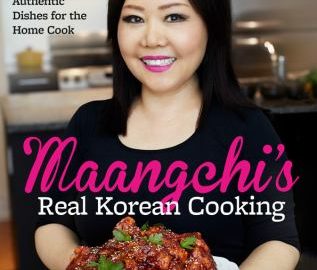
Biblioibites in April: Anyeong-haseyo* Korea!
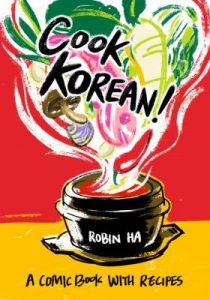 Our April meeting opened with a question: why Korea, as in what was the impetus for choosing this particular cuisine? While the short answer is, “why not,” there’s a bit more to it than that. Korean food’s profile in the US has been steadily rising over the last ten years or so; information and ingredients have become much more readily available (at least in metropolitan areas), Korean restaurants have sprouted (bean-sprouted?) up in towns both large and small, and food articles in magazines and newspapers regularly feature recipes for some of Korea’s iconic dishes, like kimchi or bibimbap. So it seems that Korean food has arrived and is poised to become as common and beloved as, say, Chinese, Thai, or Italian.
Our April meeting opened with a question: why Korea, as in what was the impetus for choosing this particular cuisine? While the short answer is, “why not,” there’s a bit more to it than that. Korean food’s profile in the US has been steadily rising over the last ten years or so; information and ingredients have become much more readily available (at least in metropolitan areas), Korean restaurants have sprouted (bean-sprouted?) up in towns both large and small, and food articles in magazines and newspapers regularly feature recipes for some of Korea’s iconic dishes, like kimchi or bibimbap. So it seems that Korean food has arrived and is poised to become as common and beloved as, say, Chinese, Thai, or Italian.
Still, it’s fair to say that most of us aren’t all that familiar with Korean food, and it can be intimidating to experiment with unknown ingredients and new flavor combinations. This month’s titles gave us plenty of advice and assistance in navigating our way through uncharted waters!
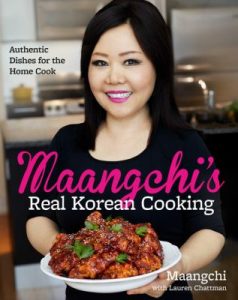 There are many websites that have information about, and recipes for, Korean food. One of the better-known ones is written by Maangchi. Her blog and videos have become so popular that she eventually wrote a cookbook, Maangchi’s Real Korean Cooking, which a few of us tried out. The book is large-format with heavy, glossy paper and plenty of photos, which are extra-helpful when you’re completely unsure what a finished dish should look like. Maangchi’s “voice” is friendly and helpful– it’s almost like having a Korean friend in your kitchen. We liked that she provides general information about the composition and presentation of a Korean meal; the book also has a nice glossary of Korean ingredients (with helpful photos of each), and a list of possible substitutions. Two additional titles we used,
There are many websites that have information about, and recipes for, Korean food. One of the better-known ones is written by Maangchi. Her blog and videos have become so popular that she eventually wrote a cookbook, Maangchi’s Real Korean Cooking, which a few of us tried out. The book is large-format with heavy, glossy paper and plenty of photos, which are extra-helpful when you’re completely unsure what a finished dish should look like. Maangchi’s “voice” is friendly and helpful– it’s almost like having a Korean friend in your kitchen. We liked that she provides general information about the composition and presentation of a Korean meal; the book also has a nice glossary of Korean ingredients (with helpful photos of each), and a list of possible substitutions. Two additional titles we used, 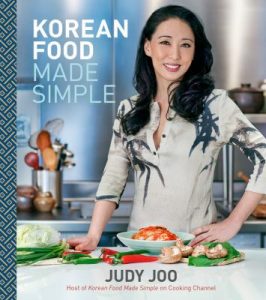 Korean Food Made Simple by Judy Joo, and The Kimchi Chronicles by Marja Vongerichten, had similar formats and equally useful ingredient glossaries. These two titles were both written in conjunction with TV shows: Joo’s book came out of a Cooking Channel show, and Vongerichten’s is a companion to a 2011 PBS series. All three titles aim (successfully) to demystify Korean cooking and make it accessible to all.
Korean Food Made Simple by Judy Joo, and The Kimchi Chronicles by Marja Vongerichten, had similar formats and equally useful ingredient glossaries. These two titles were both written in conjunction with TV shows: Joo’s book came out of a Cooking Channel show, and Vongerichten’s is a companion to a 2011 PBS series. All three titles aim (successfully) to demystify Korean cooking and make it accessible to all. 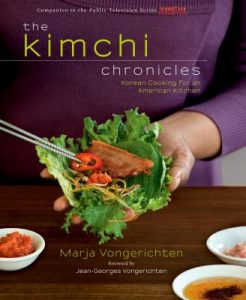 Finally, just for fun, we checked out Cook Korean! by Robin Ha. This unique book is written in graphic-novel format, which was fun to read, though it was sometimes a bit tricky to follow the flow of the drawings. And since those illustrations were drawings rather than photos, they weren’t quite as helpful at the market; we did enjoy the short comics within the book that told stories about the author’s life and cooking journey.
Finally, just for fun, we checked out Cook Korean! by Robin Ha. This unique book is written in graphic-novel format, which was fun to read, though it was sometimes a bit tricky to follow the flow of the drawings. And since those illustrations were drawings rather than photos, they weren’t quite as helpful at the market; we did enjoy the short comics within the book that told stories about the author’s life and cooking journey.
All of these books had (of course) recipes for kimchi, and a few of us took the plunge and attempted this quintessential dish. This recipe is also one of the few that necessitated a trip to a Korean market, as it requires hot pepper flakes, which are unavailable in local supermarkets. We agreed that it certainly wasn’t hard to make, though it took some time between the chopping of vegetables, salting and then draining them, combining with the seasonings, and then fermenting for a few days. Some of us used considerably less pepper flakes than was called for– but this is the virtue of making it yourself! One person thought it was a fun experiment, and the kimchi was good, but not so much so that she wanted to make it again. Some in the group don’t care for the characteristic sourness of kimchi, though this can be controlled somewhat by refrigerating the kimchi as soon as it’s made, so it ferments much more slowly. Or you could try water kimchi, which is made without red pepper and is “crunchy and refreshing.”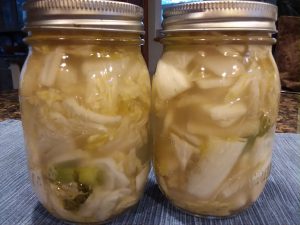
Several of the recipes in both Korean Food Made Simple and Kimchi Chronicles were Korean-inspired rather than authentically Korean; most of these were quick to make and more approachable from a Western perspective– perhaps you could say that they are “gateway recipes”! A few of us made 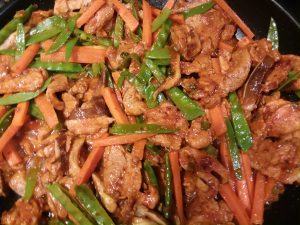 spicy pork stir-fry and thought it was absolutely delicious. The pork and vegetables were cooked in a flavorful sauce featuring gochujang (red pepper paste), a key ingredient for Korean cooks (one person discovered this ingredient at Target– so you know Korean food has really gone mainstream!). Scallion salad was a quick side dish that was “really good,” as was spice-rubbed Korean chicken. Ginger fried rice was “the best fried rice ever,” and kimchi fried rice was a tasty vehicle for kimchi– if you like kimchi. Beef bulgogi was too sweet, though the marinade was a tasty combination overall. Bibimbap made use of leftover bulgogi, as well as the traditional assortment of vegetables. Served atop rice, it’s a savory bowl of wonderful flavors and textures. All of the above recipes from Kimchi Chronicles. Both mom’s bbq chicken
spicy pork stir-fry and thought it was absolutely delicious. The pork and vegetables were cooked in a flavorful sauce featuring gochujang (red pepper paste), a key ingredient for Korean cooks (one person discovered this ingredient at Target– so you know Korean food has really gone mainstream!). Scallion salad was a quick side dish that was “really good,” as was spice-rubbed Korean chicken. Ginger fried rice was “the best fried rice ever,” and kimchi fried rice was a tasty vehicle for kimchi– if you like kimchi. Beef bulgogi was too sweet, though the marinade was a tasty combination overall. Bibimbap made use of leftover bulgogi, as well as the traditional assortment of vegetables. Served atop rice, it’s a savory bowl of wonderful flavors and textures. All of the above recipes from Kimchi Chronicles. Both mom’s bbq chicken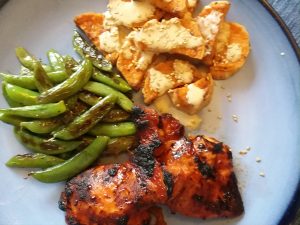 and Korean pulled pork from Korean Food Made Simple were hits– the chicken was moist and delicious with lots of flavor. It featured an excellent dipping sauce, as well. The pork was yummy and simple– savory, sweet, and spicy all at once. A keeper!
and Korean pulled pork from Korean Food Made Simple were hits– the chicken was moist and delicious with lots of flavor. It featured an excellent dipping sauce, as well. The pork was yummy and simple– savory, sweet, and spicy all at once. A keeper!
Maangchi’s book is perhaps the most authentic one we road-tested, but that didn’t stop people from diving in. Steamed eggplant was easy and a keeper, as was blanched spinach with scallions and sesame. Seafood-scallion pancakes, though different than the Chinese variety, were delicious with generous amounts of their namesake ingredients. The ridiculously simple dipping sauce was the perfect accent. Korean-style zucchini pancakes weren’t pancakes per se, but rather lightly breaded and fried zucchini slices. They were served with creamy pine nut sauce; the sweet-and-sour sauce was a good foil for the tender zucchini. Korean-style curry rice required a trip to a specialty store to buy Korean curry powder, but the completed dish was so good it was worth the effort. Panfried tofu didn’t sound like it would be tasty, but turned out to be “much better than expected;” it also had a very flavorful dipping sauce. We sampled the braised lotus root at our meeting; it was crunchy with a delicious slightly sweet glaze. A few of us tried the iconic jjajangmyeon (noodles with black bean paste). This is an extremely popular, ubiquitous dish adopted from China, but all of us who made it thought it was pretty boring. (I did think it tasted better after sitting in the fridge for a couple of days). Japchae, another classic Korean noodle dish, was excellent, with its nicely chewy noodles, stir-fried vegetables, and marinated beef.
One drawback of much of Korean cooking can be inferred from some of the above descriptions: there is a lot of prep, as most ingredients need to be diced, shredded, or cut into matchsticks. However, you do save time on the cooking end, since all those small pieces of food cook quickly. The extensive prep, and numerous sauces, also led to a mountain of dirty dishes, so be warned if you don’t have a dishwasher! Most of the recipes in these books had many common ingredients, which was good for using up our stashes of Korean sauces, pastes, and hot pepper, but sometimes that made it seem that everything had the same flavors. One quirk we discovered is that several popular Korean recipes use some distinctly American ingredients, like Spam, American cheese, canned tuna, and hot dogs– a legacy of the US’s participation in the Korean War. Many of these items show up in Korean comfort foods like stews and noodle soups. Maangchi has a recipe for kimchi stew with tuna, which sounded a bit weird but tasted delicious. Kimchi Chronicles‘ recipe for fried rice with kimchi advises us to melt American cheese on top of the finished dish, as this is considered comfort food at its finest.
Will we continue to cook Korean? For most of us, it’s not in our wheelhouse and requires extra effort in the shopping and prep department; so perhaps it would be more now-and-then rather than every week. At least now if we want Korean food we can go to a restaurant instead of having to make it ourselves; and some experience with Korean flavors and ingredients makes it easier, more fun, and more delicious when we order takeout or stop at a Korean restaurant. If you want to cook Korean yourself, any of the books we tried would be a good choice; they were all clearly written, easy to use, and loaded with explanatory photographs. Because we had four titles, we didn’t rate them, as each individual book was used by very few people.
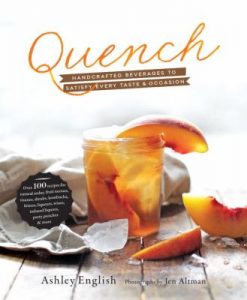 Our next meeting will be on Friday, June 1 at 11 AM in the Fireplace Room. Please note the date change; we will not meet on May 25 but on June 1. May’s title is Quench: handcrafted beverages to satisfy every taste and occasion by Ashley English. Copies are available at the main desk.
Our next meeting will be on Friday, June 1 at 11 AM in the Fireplace Room. Please note the date change; we will not meet on May 25 but on June 1. May’s title is Quench: handcrafted beverages to satisfy every taste and occasion by Ashley English. Copies are available at the main desk.
*Anyeong-haseyo = Hello!






